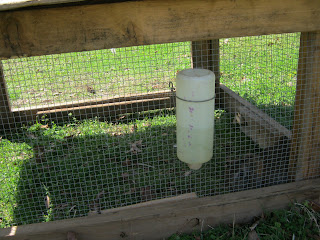I thought I would try to describe for you how we raise rabbits at the Shamrock and Thistle Farm.
We believe in keeping our animals in as natural a habitat as possible. Rabbits, therefore, were not created to live in wire cages suspended four feet from the ground. While we understand why this is a common practice (rabbits like to burrow) we think we have found another way - a better way.
This is our buck, Louis. He is a mini French Lop, hence the name Louis. He is actually Louis the Second. One day I made this range shelter out of three 8' two by fours, 16ft of hardware cloth and about 4ft of scrap 1x2s. The two by fours make up the box, then I wrap the box with hardware cloth and secure it with the scrap 1x2s. Louis does not have a strong burrowing instinct so he gets to roam around within his box without wire fencing underneath. He gets to eat all the grass, hen-bit, chickweed, dock, and clover he wants. Once he eats this patch up I will slide the box over to a fresh area and he can start feasting again. Aside from the water container hanging on the fence I do not have to supplement this natural pasture feed at all.
Once the doe has been to visit Louis II and spent a vacation of 30 days in a nesting box inside the barn, she and her kits are turned back out onto pasture in a double length shelter. This shelter was made by joining two 4x4 shelters together. As you can see, the shelter sits upon a stretch of welded wire fence that is curled up on the outside edges to prevent burrowing. This allows the rabbits to eat pasture through the 2x4 inch spaces in the fence. Because this shelter is now housing 14 rabbits (2 does and 12 kits) they eat this 32 square foot patch in less than a day. Every morning I move them to a new patch and only supplement their feed if they start to dig.
Tto the right of the shelter you can see the bare patch where they ate the pasture down and manured it for a day. In this picture they are busily eating the new patch of pasture down to the ground and fertilizing while they go. To the left a new patch of tall green pasture waiting for the big move tomorrow.
Another secret to preventing burrowing that we have pieced together over the years is this: Keep the rabbits on fresh pasture. They would rather be eating than escaping any time. Provide them a plain 360 degree line of sight around the box. That means no walls. We set up a temporary wall (the plywood lying on the ground in the picture above) if a storm comes through to keep rain and wind off of them. If they can see there is no danger they will not try to escape. And lastly, give them a box to crawl into or on top of. For some reason, they like to sit on top and look around.
The whole process from 1 buck and 4 does to 30 or so rabbits ready to eat is about 80 days with this method. 2 weeks courtship and mating, 4 weeks in a nest box, 30 days in a range shelter.
the result is very happy rabbits, lean tasty meat, and the most humane way of providing rabbit meat for our customers.
One additional note: we are trying to research the regulations for the sale of rabbit in the state of arkansas and no one seems to know what that is. The USDA refers us to the UofA Ag-Law Center, the law center refers us to the USDA. The USDA will take "voluntary" inspections but if a grower does not volunteer then it falls under the FDA. The FDA is interested in rabbits only for their pharmaceutical uses (don't ask. I am sorry I did).
So we hope to be offering this tasty meat for sale at our local community markets soon.



No comments:
Post a Comment